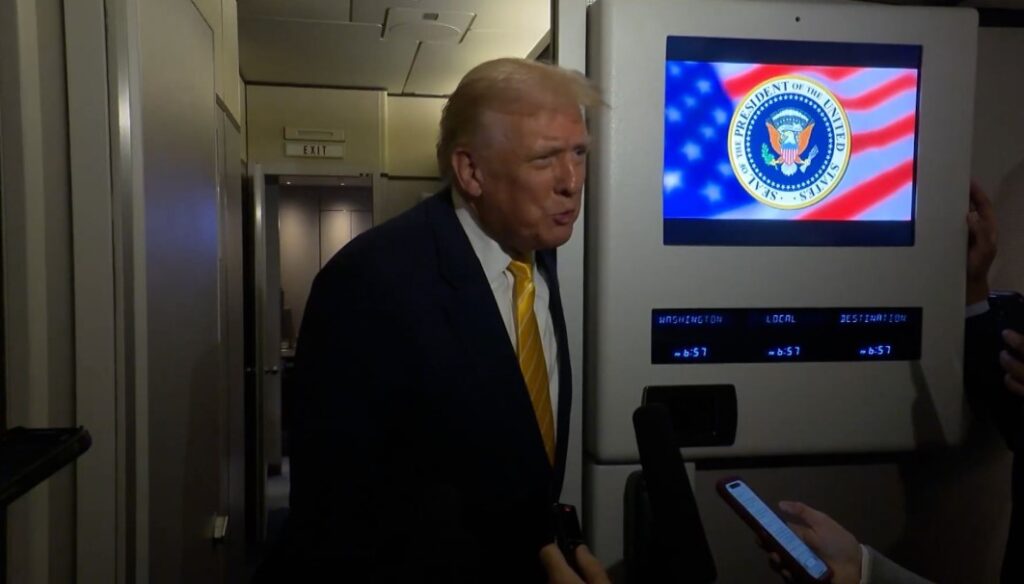The phrase Trump Epstein reporter remark has become a major point of discussion after a tense moment unfolded aboard Air Force One. The incident occurred when former President Donald Trump was questioned about newly released emails related to Jeffrey Epstein, emails in which his name reportedly appeared. What followed quickly ignited headlines, social media debates, and renewed scrutiny surrounding the Epstein case.
This article breaks down the event in detail, explains the broader context, and examines why the Trump Epstein reporter remark continues to spark strong reactions.

Trump Epstein Reporter Remark and the Email Questions
When the press boarded Air Force One on November 14, journalists were eager to address the newly surfaced Epstein-related communications. These emails contained several high-profile names, including Trump and Bill Clinton, making them a central topic of interest.
A Bloomberg reporter asked Trump to comment on why Epstein’s emails referenced him. Trump responded that he had no knowledge of the communication and claimed the attention should instead be directed at other people mentioned in the documents.
His response was straightforward, but the tension escalated when the reporter attempted a follow-up question.
The Moment Tension Escalated
The Trump Epstein reporter remark was delivered when the journalist attempted to ask for clarification. Trump sharply turned toward her and said:
“Quiet. Quiet, piggy.”
Those three words immediately drew controversy. Video clips circulated within minutes, generating millions of views online. Regardless of political alignment, many observers expressed shock at the tone, while others defended the remark as typical of Trump’s confrontational media style.
This adds another layer to the long-running friction between Trump and certain press outlets.
Why the Reporter’s Question Was Important
The question that preceded the Trump Epstein reporter remark was tied to public demands for transparency. Epstein, a convicted sex offender, died in prison in 2019 while facing federal charges. Several major political figures, celebrities, and financial leaders had prior associations with him.
For years, many citizens, investigators, and advocacy groups have pushed for full disclosure of all Epstein-related materials. The release of emails created renewed pressure on officials, and the media felt obligated to demand clarity.
Trump’s reaction, therefore, became intertwined with a broader narrative about transparency, power, and accountability.
Calls for Releasing Epstein Files Intensify
The Trump Epstein reporter remark happened at the very same time public calls were increasing for the U.S. Department of Justice to release the remaining sealed Epstein case files.
What surprised many was Trump’s stance shortly afterward.
Only days later, the former president changed his position and openly urged Republicans to support a bill that would force the DOJ to release every Epstein-related document. His reversal drew attention from both supporters and critics, highlighting the political weight that the Epstein case continues to carry.
This shift also added renewed interest in the incident, as many questioned whether public pressure influenced the change.
Why the Trump Epstein Reporter Remark Went Viral
Several factors explain why the moment spread so widely:
-
The topic itself, Epstein, remains high-profile and deeply controversial.
-
Trump’s history of confrontations with journalists amplified reactions.
-
Social media algorithms prioritize high-emotion clips.
-
The phrasing “Quiet, piggy” was unusual and striking.
The viral nature of such moments often overshadows the underlying issue—public access to crucial criminal investigation documents.
Implications for Media-Political Relations
The Trump Epstein reporter remark also reignited the ongoing debate regarding how public figures should address the press. Supporters argue that Trump frequently pushes back against what he perceives as unfair or biased questioning. Critics counter that such comments may contribute to hostility toward journalists and undermine civil discourse.
The episode’s visibility ensures it will be referenced in future discussions on media treatment, press freedom, and political communication.
Contextualizing the Remark Within Trump’s History
This wasn’t the first time Trump engaged in sharp exchanges with journalists. Throughout his political career, he has developed a reputation for blunt responses, particularly when asked questions he considers unfair or aggressive.
However, even among past confrontations, the Trump Epstein reporter remark stood out due to:
-
the sensitive nature of the topic
-
heightened public attention on the Epstein case
-
the emotionally charged phrasing
These elements combined to make it one of the most widely shared moments in recent months.

Why This Story Matters
The Trump Epstein reporter remark is more than a viral clip, it connects to broader themes:
-
public trust in government
-
the need for transparency regarding criminal investigations
-
how power dynamics shape press interactions
-
the political and social weight of the Epstein case
As calls for full disclosure grow louder, every public exchange related to the case adds fuel to public interest and inquiry.
For many, the remark symbolizes the tension between elected leaders and the media. For others, it marks another chapter in the ongoing effort to learn the full truth behind one of the most notorious criminal cases of the last two decades.

